Comprehensive Guide to Matplotlib.axis.Tick.set_transform() Function in Python
Matplotlib.axis.Tick.set_transform() function in Python is a powerful tool for customizing the appearance and behavior of tick marks in Matplotlib plots. This function allows you to apply transformations to individual tick marks, giving you fine-grained control over their positioning and orientation. In this comprehensive guide, we’ll explore the Matplotlib.axis.Tick.set_transform() function in depth, covering its usage, parameters, and various applications in data visualization.
Understanding the Matplotlib.axis.Tick.set_transform() Function
The Matplotlib.axis.Tick.set_transform() function is a method of the Tick class in Matplotlib’s axis module. It is used to set the transform for a specific tick mark. This function is particularly useful when you need to apply custom transformations to individual ticks, which can be helpful in creating specialized plots or adjusting the appearance of your visualizations.
Let’s start with a simple example to demonstrate the basic usage of Matplotlib.axis.Tick.set_transform():
import matplotlib.pyplot as plt
import numpy as np
from matplotlib.transforms import Affine2D
# Create a simple plot
fig, ax = plt.subplots()
ax.plot([1, 2, 3, 4], [1, 4, 2, 3], label='Data from how2matplotlib.com')
# Get the first x-axis tick
tick = ax.xaxis.get_major_ticks()[0]
# Create a custom transform
transform = Affine2D().rotate_deg(45) + ax.transAxes
# Apply the transform to the tick
tick.set_transform(transform)
plt.legend()
plt.title('Using Matplotlib.axis.Tick.set_transform()')
plt.show()
Output:
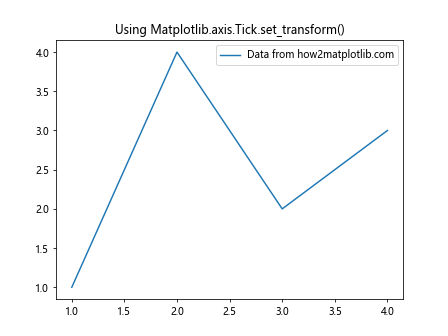
In this example, we create a simple line plot and then apply a 45-degree rotation transform to the first x-axis tick using the Matplotlib.axis.Tick.set_transform() function. This demonstrates how you can manipulate individual ticks to achieve custom effects.
Parameters of Matplotlib.axis.Tick.set_transform()
The Matplotlib.axis.Tick.set_transform() function takes a single parameter:
transform: This parameter is a matplotlib.transforms.Transform object that defines the transformation to be applied to the tick.
Understanding the transform parameter is crucial for effectively using the Matplotlib.axis.Tick.set_transform() function. Let’s explore some common types of transformations you can use:
1. Affine Transformations
Affine transformations are the most common type of transformations used with Matplotlib.axis.Tick.set_transform(). These include rotations, translations, scaling, and shearing. Here’s an example that demonstrates scaling a tick:
import matplotlib.pyplot as plt
import numpy as np
from matplotlib.transforms import Affine2D
fig, ax = plt.subplots()
ax.plot([1, 2, 3, 4], [1, 4, 2, 3], label='Data from how2matplotlib.com')
tick = ax.xaxis.get_major_ticks()[1]
transform = Affine2D().scale(2, 1) + ax.transAxes
tick.set_transform(transform)
plt.legend()
plt.title('Scaling a Tick with Matplotlib.axis.Tick.set_transform()')
plt.show()
Output:
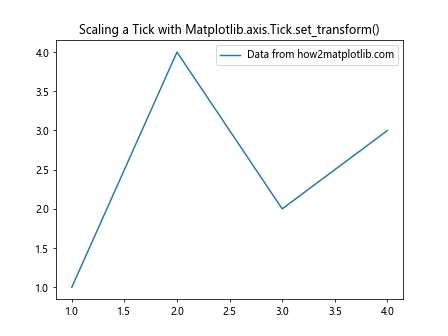
In this example, we scale the second x-axis tick horizontally by a factor of 2 using an Affine2D transformation.
2. Composite Transformations
You can combine multiple transformations to create more complex effects. Here’s an example that rotates and translates a tick:
import matplotlib.pyplot as plt
import numpy as np
from matplotlib.transforms import Affine2D
fig, ax = plt.subplots()
ax.plot([1, 2, 3, 4], [1, 4, 2, 3], label='Data from how2matplotlib.com')
tick = ax.yaxis.get_major_ticks()[2]
transform = Affine2D().rotate_deg(30).translate(0, 0.1) + ax.transAxes
tick.set_transform(transform)
plt.legend()
plt.title('Composite Transform with Matplotlib.axis.Tick.set_transform()')
plt.show()
Output:
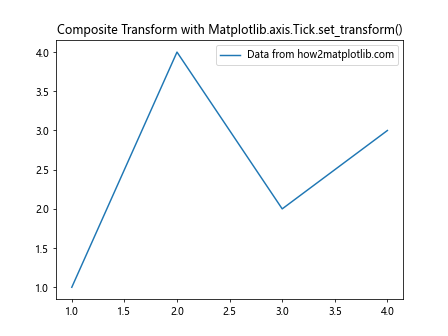
This example applies a 30-degree rotation followed by a vertical translation to the third y-axis tick.
Applications of Matplotlib.axis.Tick.set_transform()
Now that we understand the basics of the Matplotlib.axis.Tick.set_transform() function, let’s explore some practical applications and advanced techniques.
1. Creating Radial Tick Labels
One interesting application of Matplotlib.axis.Tick.set_transform() is creating radial tick labels for polar plots. Here’s an example:
import matplotlib.pyplot as plt
import numpy as np
from matplotlib.transforms import Affine2D
fig, ax = plt.subplots(subplot_kw=dict(projection='polar'))
ax.set_ylim(0, 10)
ax.set_yticks(np.arange(1, 11))
for tick in ax.yaxis.get_major_ticks():
angle = tick.get_loc() * np.pi / 180
transform = Affine2D().rotate(-angle) + ax.transAxes
tick.set_transform(transform)
tick.label1.set_rotation(0)
ax.set_title('Radial Ticks with Matplotlib.axis.Tick.set_transform()')
plt.text(0, 0, 'how2matplotlib.com', ha='center', va='center')
plt.show()
Output:
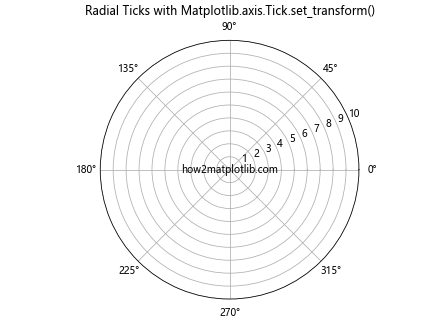
In this example, we create a polar plot and use Matplotlib.axis.Tick.set_transform() to rotate each tick label so that it’s aligned radially.
2. Custom Tick Positioning
You can use Matplotlib.axis.Tick.set_transform() to position ticks in unconventional ways. Here’s an example that places ticks along a sine curve:
import matplotlib.pyplot as plt
import numpy as np
from matplotlib.transforms import Affine2D
fig, ax = plt.subplots(figsize=(10, 6))
x = np.linspace(0, 2*np.pi, 100)
y = np.sin(x)
ax.plot(x, y, label='Sine curve from how2matplotlib.com')
for i, tick in enumerate(ax.xaxis.get_major_ticks()):
x_pos = i * 2*np.pi / 5
y_pos = np.sin(x_pos)
transform = Affine2D().translate(x_pos, y_pos) + ax.transData
tick.set_transform(transform)
plt.legend()
plt.title('Custom Tick Positioning with Matplotlib.axis.Tick.set_transform()')
plt.show()
Output:
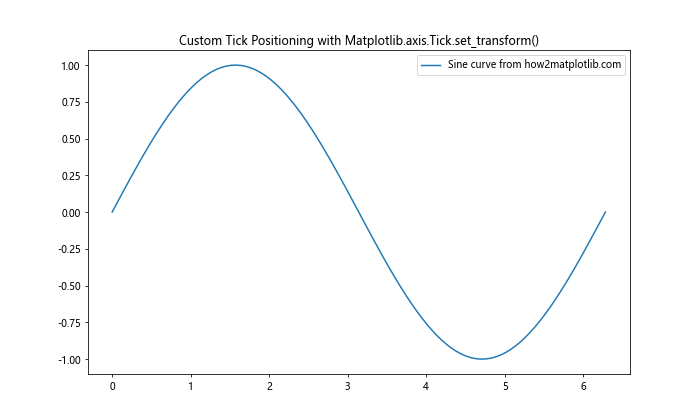
This example positions the x-axis ticks along the sine curve, demonstrating how Matplotlib.axis.Tick.set_transform() can be used for creative tick placement.
3. Emphasizing Specific Ticks
You can use Matplotlib.axis.Tick.set_transform() to emphasize certain ticks by scaling them. Here’s an example:
import matplotlib.pyplot as plt
import numpy as np
from matplotlib.transforms import Affine2D
fig, ax = plt.subplots()
ax.plot([1, 2, 3, 4, 5], [2, 4, 1, 3, 5], label='Data from how2matplotlib.com')
for i, tick in enumerate(ax.xaxis.get_major_ticks()):
if i % 2 == 0: # Emphasize every other tick
transform = Affine2D().scale(1.5, 1.5) + ax.transAxes
tick.set_transform(transform)
plt.legend()
plt.title('Emphasizing Ticks with Matplotlib.axis.Tick.set_transform()')
plt.show()
Output:
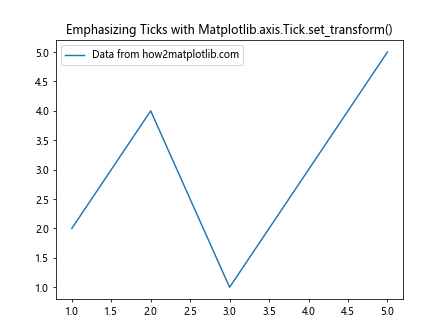
In this example, we scale up every other x-axis tick to make them stand out.
Advanced Techniques with Matplotlib.axis.Tick.set_transform()
Let’s explore some more advanced techniques using the Matplotlib.axis.Tick.set_transform() function.
1. Animated Tick Transformations
You can create animated plots where tick transformations change over time. Here’s an example:
import matplotlib.pyplot as plt
import numpy as np
from matplotlib.animation import FuncAnimation
from matplotlib.transforms import Affine2D
fig, ax = plt.subplots()
ax.set_xlim(0, 2*np.pi)
ax.set_ylim(-1, 1)
line, = ax.plot([], [], label='Sine wave from how2matplotlib.com')
def init():
line.set_data([], [])
return line,
def animate(frame):
x = np.linspace(0, 2*np.pi, 100)
y = np.sin(x - frame/10)
line.set_data(x, y)
for i, tick in enumerate(ax.xaxis.get_major_ticks()):
angle = frame * np.pi / 180
transform = Affine2D().rotate(angle) + ax.transAxes
tick.set_transform(transform)
return line,
anim = FuncAnimation(fig, animate, init_func=init, frames=360, interval=20, blit=True)
plt.legend()
plt.title('Animated Ticks with Matplotlib.axis.Tick.set_transform()')
plt.show()
Output:
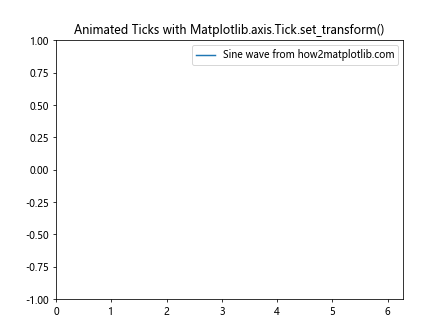
This example creates an animation where the x-axis ticks rotate as a sine wave moves across the plot.
2. Custom Tick Shapes
You can combine Matplotlib.axis.Tick.set_transform() with custom tick markers to create unique tick styles:
import matplotlib.pyplot as plt
import numpy as np
from matplotlib.transforms import Affine2D
from matplotlib.patches import RegularPolygon
fig, ax = plt.subplots()
ax.plot([1, 2, 3, 4], [1, 4, 2, 3], label='Data from how2matplotlib.com')
for i, tick in enumerate(ax.xaxis.get_major_ticks()):
marker = RegularPolygon((0, 0), numVertices=3, radius=0.1, orientation=np.pi/2)
transform = Affine2D().rotate_deg(i*30) + ax.transAxes
tick.tick1line.set_marker(marker)
tick.tick1line.set_markersize(10)
tick.tick1line.set_transform(transform)
plt.legend()
plt.title('Custom Tick Shapes with Matplotlib.axis.Tick.set_transform()')
plt.show()
This example creates triangular tick marks and rotates each one using Matplotlib.axis.Tick.set_transform().
3. Non-linear Tick Spacing
You can use Matplotlib.axis.Tick.set_transform() to create non-linear tick spacing:
import matplotlib.pyplot as plt
import numpy as np
from matplotlib.transforms import Affine2D
fig, ax = plt.subplots()
x = np.linspace(0, 10, 100)
y = np.exp(x)
ax.plot(x, y, label='Exponential curve from how2matplotlib.com')
for i, tick in enumerate(ax.xaxis.get_major_ticks()):
x_pos = i**2
transform = Affine2D().translate(x_pos, 0) + ax.transData
tick.set_transform(transform)
plt.legend()
plt.title('Non-linear Tick Spacing with Matplotlib.axis.Tick.set_transform()')
plt.show()
Output:
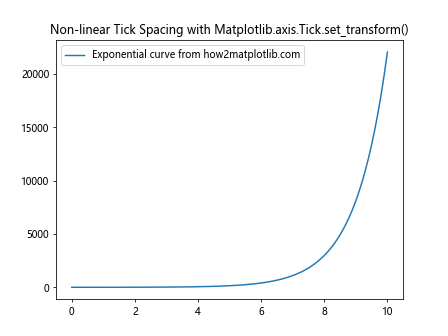
This example spaces the x-axis ticks according to a quadratic function, resulting in non-linear tick spacing.
Best Practices for Using Matplotlib.axis.Tick.set_transform()
When working with the Matplotlib.axis.Tick.set_transform() function, it’s important to keep some best practices in mind:
- Consistency: When applying transformations to ticks, try to maintain consistency across your plot. Inconsistent transformations can lead to confusing or misleading visualizations.
Readability: While creative tick transformations can be visually interesting, always prioritize the readability of your plot. Ensure that transformed ticks don’t obscure data or make it difficult to interpret the plot.
Performance: Applying complex transformations to many ticks can impact performance, especially in interactive or animated plots. Use transformations judiciously and consider simplifying them if performance becomes an issue.
Documentation: If you’re using unusual tick transformations, it’s a good idea to document them in your plot’s legend or caption. This helps viewers understand what they’re seeing.
Coordinate Systems: Be mindful of the coordinate system you’re working in. Transformations applied in data coordinates will behave differently from those applied in axes or figure coordinates.
Here’s an example that demonstrates these best practices: